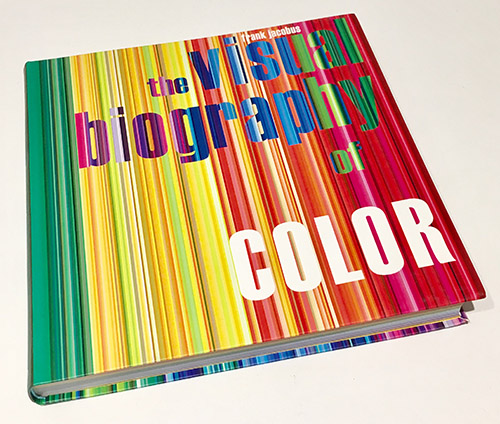
FAYETTEVILLE, Ark. – A new book reveals color across time by presenting information through graphics and other forms of visualization to describe color's cultural role. The book moves the reader through the color spectrum using a wide variety of graphics.
The Visual Biography of Color was written by Frank Jacobus, an associate professor of architecture and the 21st Century Chair of Construction and Technology in the Fay Jones School of Architecture and Design at the University of Arkansas. The book is described as a first chance at a second look at color, which is habitually overlooked in everyday living.
"When we were looking at this idea of color, it wasn't in a scientific sense but rather in a cultural sense, such as how has it impacted us in ways we do not even know. We all carry with us an idea of color that is culturally ingrained," Jacobus said.
The book, published by Oro Editions, considers various elements of color's impact on culture, from both lowbrow and highbrow perspectives, allowing readers to truly see how color and culture are undeniably intertwined. With the diverse areas of culture represented in the book, there is something to appeal to everyone.
As readers move through the visible spectrum, they are able to exist within each individual color through various cultural phenomena. Starting with red, they are introduced to when each state in the United States has voted Republican in every presidential election in the country's history. Another diagram reveals a compilation of every red subway line in every major international city, and yet another shows a radiant wheel that displays songs with the word red in their titles.
"We used the color spectrum and attempted to represent every color as equally as possible. The idea was that, as a reader is flipping through the book, they are moving through the color spectrum itself. And as you move through the spectrum, you see where color has had a cultural impact," Jacobus said.
The 270-plus-page book uses numerous forms of visualization to convey the complexity of color within each culture. Some of the data visualization methods include compilations, radiant wheels and informational charts.
For Jacobus, data visualization is defined as "taking or drawing from a chaotic field of information, and organizing and restructuring that information into a discernible image that has a compelling aesthetic."
With these forms of data visualization, the reader can explore how artists, musicians and other great thinkers have viewed and used color throughout history. For Jacobus, this was a deeply personal project, as many of the great thinkers displayed throughout the book are beloved by him.
Jacobus said that the book was published with the intention of appealing to a niche audience that has an appreciation for art and graphic design, as well as being compelled by graphic visualization.
If there was only one thing a reader would take away from The Visual Biography of Color, he said, it would be for readers to realize "what a deliciously, beautifully colored world we live in."
For Jacobus, the most interesting learning opportunity during this creative process was that a hippopotamus could be purple. Some of the favorites to work on included The General Jumps, which represents every jump the General Lee car made in each episode of "The Dukes of Hazzard" television show, as well as a visualization of the musical artist Prince's album "Purple Rain."
"Some of the spreads are meant to be informational, while some are purely meant to be abstract and beautiful to look at it," Jacobus said.
While working on his previous book, Archi-Graphic: An Infographic Look at Architecture, Jacobus conceived the notion of working on a book examining color from a cultural perspective. This idea came about four years ago, but the creative process for The Visual Biography of Color only began in the last two years.
This book, similar to Archi-Graphic, was a cooperative work done with Fay Jones School students led by Jacobus. Around 25 students, who were involved with the two-year creative process to varying degrees, both influenced and inspired the final product.
Jacobus led the creative process by delegating work to students and guiding their own design process from the early stages to the finished product. "Working with young and excited students is what gives me energy," he said.
Jacobus is also a principal at SILO AR + D, an award-winning design practice operating out of Fayetteville, Cleveland, Ohio, and Charlotte, North Carolina. He currently has another collaborative piece in the works with his students that will be pitched this summer to potential publishers.
Topics
Contacts
McKenna Rhadigan, communications intern
Fay Jones School of Architecture and Design
479-575-4704, mkrhadig@uark.edu
Michelle Parks, director of communications
Fay Jones School of Architecture and Design
479-575-4704, mparks17@uark.edu